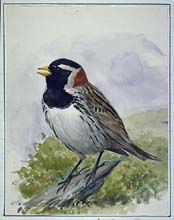Today in History: April 22
Earth Day
Earth Day was first observed in Spring of 1970. An estimated 20 million people nationwide attended festivities out of which came the largest grassroots environmental movement in U.S. history, and the impetus for national legislation like the Clean Air and Clean Water Acts. By the twentieth anniversary of that event, April 22, 1990, more than 200 million people in 141 countries participated in Earth Day celebrations.
Earth Day is not without historical precedent. Both Arbor Day and Bird Day were established in the late 1800s to support forestation, conservation, and the appreciation of nature. Native American peoples have long recognized and celebrated in story and song the interdependence of the earth and all her creatures.

Iroquois Indians, William Alexander Drennan, copyright claimant, copyright 1914.
Taking the Long View, 1851-1991
See the special presentation Chronology of Selected Events in the Development of the American Conservation Movement in the collection Evolution of the Conservation Movement, 1850-1920 to learn about milestones in U.S. efforts to preserve and protect the Earth. These efforts include the designation of some of America's most majestic national parks such as Mt. Rainier, Yosemite, and Acadia and the Grand Canyon.

Bird Painting, Louis Agazzis Fuertes, artist, July 22, 1899,
The Harriman Alaska Expedition: Chronicles and Souvenirs (page 190), May to August 1899.
Evolution of the Conservation Movement, 1850-1920
John Burroughs, John Muir, and Luis Agassiz Fuertes (at the outset of his career as the nation's most notable ornithological painter since Audubon) were among the scientists, naturalists, and artists who produced an album documenting the 1899 Harriman Alaska Expedition. The souvenir album includes maps, photographs, paintings, poems, song lyrics, and prose. It records the participants' experience of the beauty of the scenery; their field observations of Alaska's geography, wildlife, and Native peoples; and their interpersonal relationships. Examine the album by selecting pages from its digitized Table of Contents.
- The collection Evolution of the Early Conservation Movement, 1850-1920, demonstrates that works of art are integral to the legacy of the early conservation movement. Search this collection using the terms Thomas Moran or Currier & Ives to enjoy examples.
- See these Today in History pages to learn more about events in U.S. conservation history, and individuals whose intellectual or artistic legacy influenced the movement:
- To learn more about major environmental legislation currently before the U.S. Congress, search on Environmental Protection in THOMAS: Legislative Information on the Internet. It is also possible to search for a bill by its number or its name. For example, search either under S. 134 or Gaylord Nelson Apostle Islands Stewardship Act to find a bill to direct the Secretary of the Interior to study whether the Apostle Islands National Lakeshore should be protected as a wilderness area. (Search in Touring Turn-of-the-Century America, 1880-1920 on the term Apostle Islands to see images of the area discussed in the legislation.)
- See the Earth Decade Reading List available through the Library's Science Reading Room.
- The Library's Science Reference Section develops Science Tracer Bullets, which are guides to the literature on topics of current interest. Search these on the keyword Environment to locate, for example, a Tracer Bullet on Biodiversity or, for the budding environmental scientist, Environmental Science Projects.